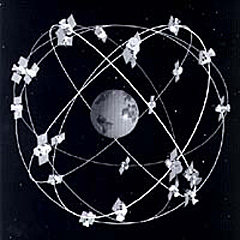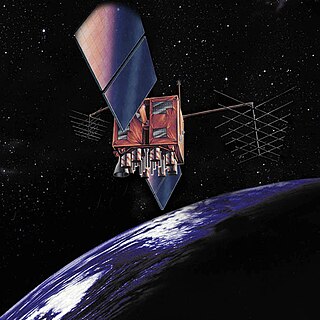USA-87, also known as GPS IIA-8, GPS II-17 and GPS SVN-29, was an American navigation satellite which formed part of the Global Positioning System. It was the eighth of nineteen Block IIA GPS satellites to be launched.

GPS satellite blocks are the various production generations of the Global Positioning System (GPS) used for satellite navigation. The first satellite in the system, Navstar 1, was launched on 22 February 1978. The GPS satellite constellation is operated by the 2nd Space Operations Squadron (2SOPS) of Space Delta 8, United States Space Force.

GPS Block IIF, or GPS IIF is an interim class of GPS (satellite) which were used to bridge the gap between previous Navstar Global Positioning System generations until the GPS Block III satellites became operational. They were built by Boeing, operated by the United States Air Force, and launched by the United Launch Alliance (ULA) using Evolved Expendable Launch Vehicles (EELV). They are the final component of the Block II GPS constellation to be launched. On 5 February 2016, the final Block IIF satellite was successfully launched, completing the series.
USA-35, also known as Navstar 2-01, GPS II-1 and GPS SVN-14, was an American navigation satellite which formed part of the Global Positioning System. It was the first of nine Block II GPS satellites to be launched, which were the first operational GPS satellites to be launched.
USA-47, also known as GPS II-4 and GPS SVN-19, was an American navigation satellite which formed part of the Global Positioning System. It was the fourth of nine Block II GPS satellites to be launched, which were the first operational GPS satellites to fly.
USA-79, also known as GPS IIA-3, GPS II-12 and GPS SVN-25, was an American navigation satellite which formed part of the Global Positioning System. It was the third of nineteen Block IIA GPS satellites to be launched.
USA-80, also known as GPS IIA-4, GPS II-13 and GPS SVN-28, was an American navigation satellite which formed part of the Global Positioning System. It was the fourth of nineteen Block IIA GPS satellites to be launched.
USA-84, also known as GPS IIA-6, GPS II-15 and GPS SVN-27, is an American navigation satellite which forms part of the Global Positioning System. It was the sixth of nineteen Block IIA GPS satellites to be launched.
USA-91, also known as GPS IIA-11, GPS II-20 and GPS SVN-37, was an American navigation satellite which formed part of the Global Positioning System. It was the eleventh of nineteen Block IIA GPS satellites to be launched.
USA-96, also known as GPS IIA-14, GPS II-23 and GPS SVN-34, is an American navigation satellite which is part of the Global Positioning System. It was 14 of 19 Block IIA GPS satellites to be launched, and the last one to be retired.

USA-150, also known as GPS IIR-4 and GPS SVN-51, is an American navigation satellite which forms part of the Global Positioning System. It was the fourth Block IIR GPS satellite to be launched, out of thirteen in the original configuration, and twenty one overall. It was built by Lockheed Martin, using the AS-4000 satellite bus.
USA-1, also known as Navstar 9, GPS I-9 and GPS SVN-9, was an American navigation satellite launched in 1984 as part of the Global Positioning System development programme. It was the ninth of eleven Block I GPS satellites to be launched, and the first satellite to receive a USA designation.

USA-260, also known as GPS IIF-9, GPS SVN-71 and NAVSTAR 73, is an American Satellite navigation which forms part of the Global Positioning System. It was the ninth of twelve Block IIF satellites to be launched.

USA-289, also known as GPS-III SV01 or Vespucci, is a United States navigation satellite which forms part of the Global Positioning System. It was the first GPS Block III satellite to be launched.

USA-293, also known as GPS-III SV02 or Magellan, is a United States navigation satellite which forms part of the Global Positioning System. It was the second GPS Block III satellite to be launched.

USA-304, also known as GPS-III SV03 or Matthew Henson, is a United States navigation satellite which forms part of the Global Positioning System. It was the third GPS Block III satellite to be launched.

USA-319, also known as GPS-III SV05, NAVSTAR 81 or Neil Armstrong, is a United States navigation satellite which forms part of the Global Positioning System. It was the fifth GPS Block III satellite to be launched.

USA-343, also known as GPS-III SV06, NAVSTAR 82 or Amelia Earhart, is a United States navigation satellite which forms part of the Global Positioning System. It was the sixth GPS Block III satellite to be launched.




